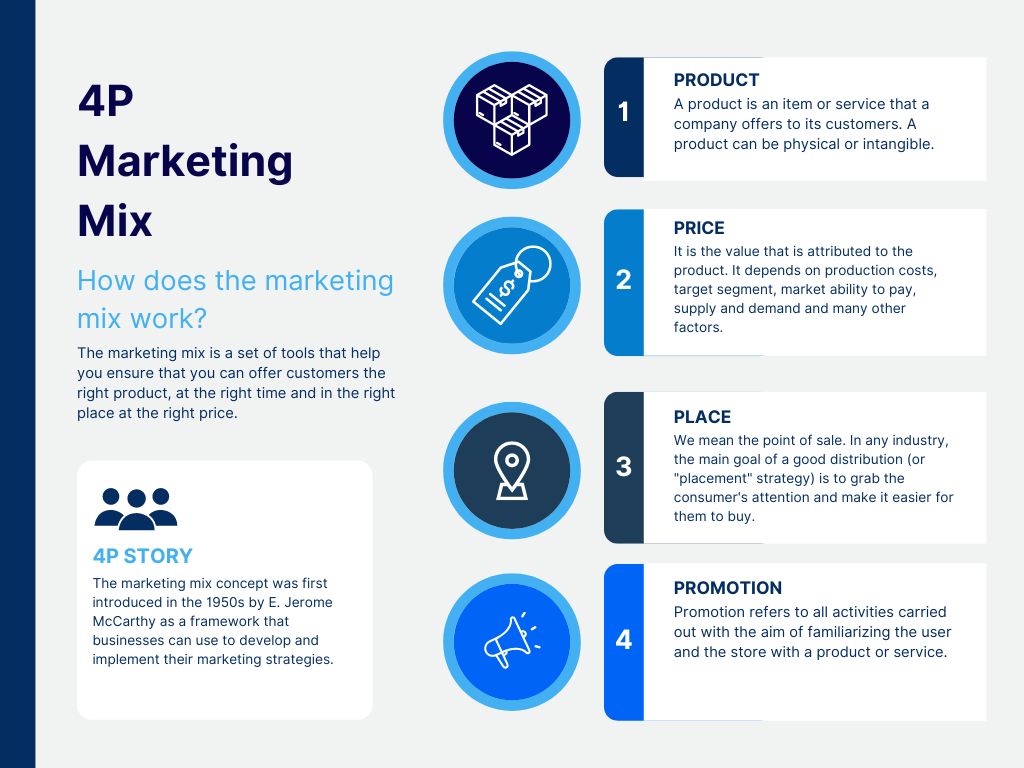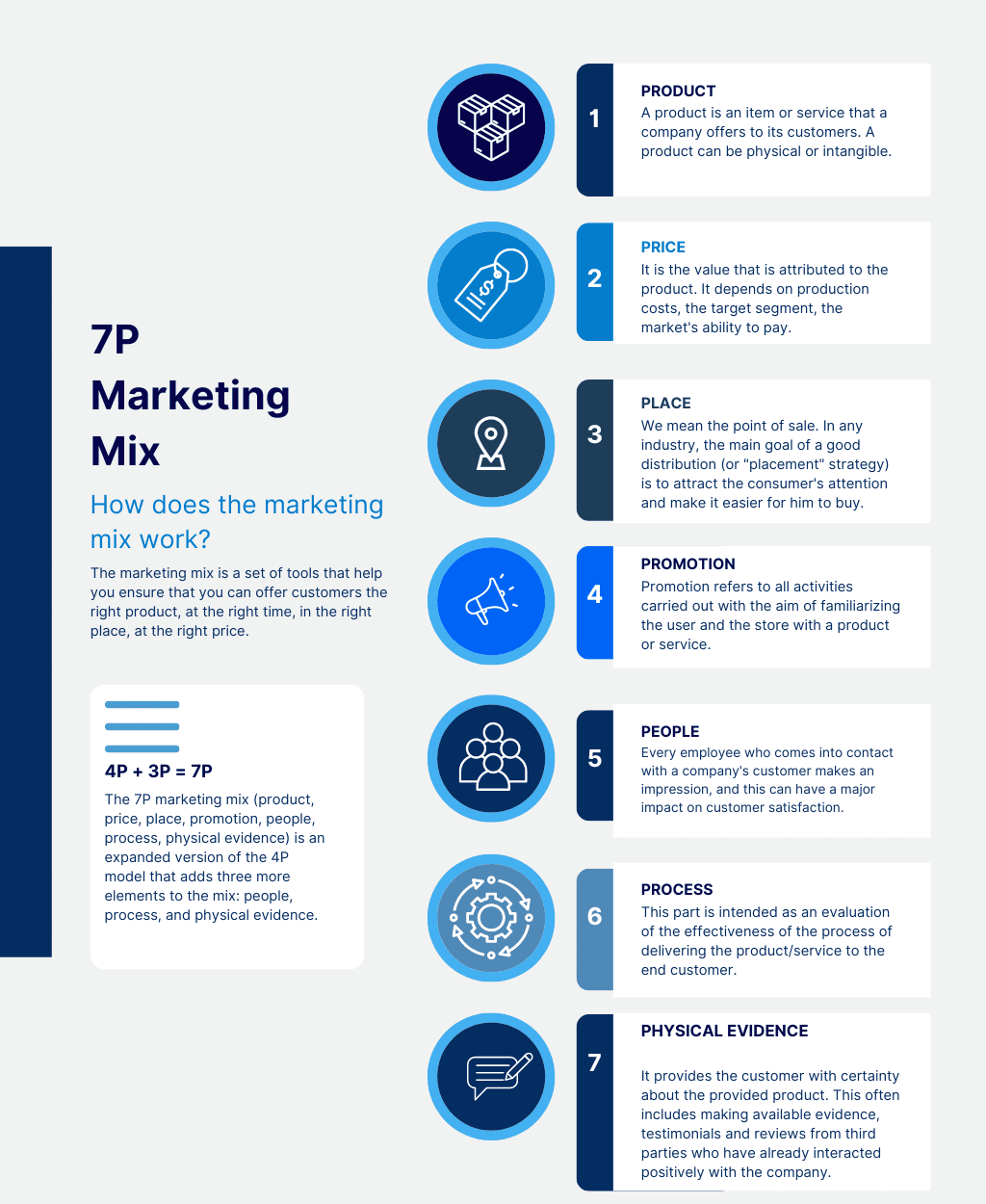How does the marketing mix work?
The marketing mix is the set of marketing strategy tools you use to create and market a product or service.
Simply put, these activities will help you ensure that you are able to offer your customers the right product, at the right time, in the right place, at the right price.
Each element of the marketing mix (product, price, distribution and communication) provides a company with different opportunities to achieve its objectives, all the while satisfying customer needs.
While this process has traditionally been implemented through the 4P marketing mix, three additional tools have now been added to the mix, creating the 7P marketing mix theory.
The product marketing mix is a strategic tool aimed at developing best practices and tactics to achieve success in the marketplace.
In contrast, the marketing strategy is structured to develop a cost-effective way to generate sales and maintain a competitive position for the company’s brands and products regardless of where they are sold.

The history of the marketing mix
The marketing mix concept was first introduced in the 1950s by E. Jerome McCarthy, Professor of Marketing at Michigan State University.
McCarthy proposed the “four P’s” of marketing as a framework that businesses can use to develop and implement their marketing strategies. The four P’s were product, price, place, and promotion.
Over the years, the marketing mix has evolved and expanded to include other elements.
For example, the 1960’s saw the addition of people and process and physical evidence was added in the 1980’s.
The concept of the marketing mix and its beginnings
The concept of the marketing mix has been widely adopted by companies and marketing professionals as a way to understand and analyse the various elements involved in creating and delivering value to customers.
It has become a standard tool for marketing planning and strategy development and is widely taught in business and marketing programs at universities and colleges.
Despite their evolution, the key elements of the marketing mix (the four Ps) are still relevant today and are widely used as a framework for businesses to develop and implement their marketing strategies.
Why is the marketing mix important for a company’s strategy?
- It helps you understand what your product or service can offer your customers
- It helps with planning a successful product offering
- It assists in the planning, development and implementation of effective marketing strategies
- It helps companies utilise their strengths and avoid unnecessary costs
- It helps with being proactive when facing risks
- It helps determine if your product or service is a good fit for your customers
- It helps you identify and understand customer requirements
- It helps you figure out when and how to promote your product or service to customers

The marketing mix is a perfect symphony
A good-quality marketing strategy is like a perfect symphony that combines different instruments into one harmonious whole.
Think of the marketing mix as a symphony of different elements that you use to achieve your goals. Your product or service is the main musical instrument and as such, it needs to be properly tuned and adapted to the needs of your audience.
Price is like a rhythm that must be adapted to be attractive to the audience while providing tempo for the orchestra.
The distribution (place) is like the stage on which the concert takes place. A suitable location must be chosen to make the product easily accessible and understandable to the audience.
Communication (promotion) is like a conductor leading an entire orchestra.
What does the 4P marketing mix contain?
Product
A product is an item or service that a company offers to its customers. The product can be physical or intangible, such as an electronic service or an experience.
If you want your product to be successful, you need to meet the needs and requirements of your target market. This includes considering factors such as design, features, packaging, brand and warranty.
You can also offer different product variants, for example different sizes or colours. This will help you reach different market segments and target groups. Effective management of the product element in the marketing mix is key to the success of the company in the marketplace.
Price
This is the value that is attributed to the product. It depends on the cost of production, the target segment, the solvency of the market, supply and demand and a number of other direct and indirect factors.
There might be a number of different types of pricing strategies, each of which is linked to an overall business plan.
Place
This refers to the point of sale. In any industry, the main objective of a good distribution (or ‘positioning’) strategy is to capture the consumer’s attention and make it easier for them to buy. Retailers pay a premium for good positioning. In fact, the mantra of successful retail is “location, location, location.”
Promotion
Promotion refers to all activities carried out to make the user and the trade aware of the product or service. This may include advertising, word of mouth, press releases, incentives, commissions and trade awards, consumer schemes, direct marketing, competitions and prizes.

Extension to the 7P marketing mix
The 7P marketing mix (product, price, place, promotion, people, process, physical evidence) is an extended version of the 4P model that adds three more elements to the mix: people, process and physical evidence.
The people element refers to the people involved in the marketing process, including employees, partners and customers. The process element refers to the processes used to create, deliver and support a product or service. Finally, the physical evidence element relates to the tangible elements of a product or service, such as packaging, branding or customer service.
People
They showcase how your business works on the inside. Every employee who comes into contact with a company’s customers makes an impression, and that can make all the difference when it comes to customer satisfaction.
In fact, many customers cannot separate the product or service from the employees who provide it. It is therefore important to assess the level of after-sales support and advice provided by the people involved.
Process
This part refers to the evaluation of the efficiency of the process of delivering the product/service to the end customer.
Several topics need to be explored for this pillar:
- Is your sales process efficient?
- Do you have a good process for solving technical issues?
- Are your processes customer-centric?
The process is one of the often overlooked P’s, but it frequently represents the first experience a customer has with your company.
Physical evidence
It provides the customer with certainty about the product provided. This often involves sharing evidence, testimonials and reviews from third parties who have already interacted positively with the company.

4P vs 7P marketing mix: what’s the difference
The difference between 4P and 7P lies in the purpose we are looking to achieve.
An enhanced marketing mix helps businesses gain a deeper understanding of how to meet customer needs and expectations. Although sometimes considered outdated, the 4P model is an essential tool that is particularly useful for small businesses that sell a “standard” product.
On the other hand, when a business specializes in providing a service or a highly differentiated product, you should choose the 7P model. In this case, customer satisfaction is shaped by customer experience and the degree of after-sales support.
Do you need help?
If you are stuck with what to do next, or if you don’t have the time and need help with preparing a marketing strategy for your business, contact us.
We’ll look at which approach is ideal for you and suggest the optimal mix of activities that will make you more profitable.






